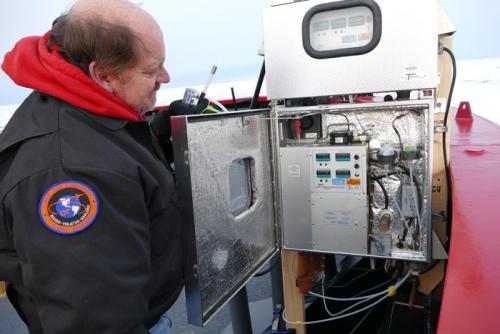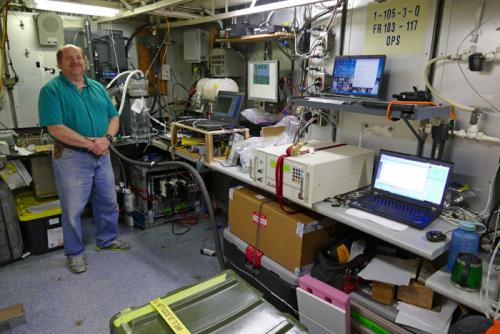Cruise Day 21
Speed 4 knots (kts)
Course 32° (NNE)
Location Makarov Basin, approx. 313nm S. of the North Pole
Depth 3248 m
GO DEEPER DISCUSSION: (see previous journal for the questions.)
The Metric System employs consistent prefixes for modifying units. Once you’ve learned the prefixes and what they mean, they can be applied to any unit. For example, a millimeter is a thousandth of a meter, and a milligram is a thousandth of a gram. When dividing units into smaller fractions, the following prefixes are used:
1/10 (0.1 or one-tenth): deci-
1/100 (0.01 or one-hundredth): centi-
1/1000 (0.001 or one-thousandth): milli-
1/1,000,000 (0.000001 or one-millionth): micro-
1/1,000,000,000 (0.000000001 or one-billionth): nano-
1/1,000,000,000,000 (0.000000000001 or one-trillionth): pico-
1/1,000,000,000,000,000 (0.000000000000001 or one-quadrillionth): femto-
1/1,000,000,000,000,000,000 (0.000000000000000001 or one-quintillionth): atto-
1/1,000,000,000,000,000,000,000 (0.000000000000000000001 or one-sextillionth): zepto-
And the smallest division in the metric system with a defined prefix is:
1/1,000,000,000,000,000,000,000,000 (0.000000000000000000000001 or one-septillionth): yocto-
TODAY’S JOURNAL:
We have a few days of transiting north, with three relatively short repeat hydrography stations planned along the way before reaching our next GEOTRACES station at approx. 87.5° latitude. We’ve now reached a latitude farther north than the northernmost point of land on Kaffeklubben Island, Greenland. We are also near the so-called “Northern Pole of Inaccessibility”, the point in the Arctic Ocean farthest from land in any direction.

Today I visited with Steve Brooks, Associate Professor at the University of Tennessee in the school of Mechanical, Aerospace, and Biomedical Engineering. Steve is a veteran of polar studies, particularly atmospheric measurements. He has been to the South Pole, the Greenland Ice Cap, and on the Arctic Ocean ice numerous times, but is planning on this being his last oceanographic research cruise. Steve is measuring several chemicals in the atmosphere, but is particularly interested in mercury. Specifically, the key process he is investigating on our cruise is how mercury is exchanged between the surface of the ocean and the atmosphere.
To measure atmospheric mercury, Steve has a Mercury Speciation System installed right on the bow of the Healy. This pulls in air and moves it though a device called a denuder, which chemically traps gaseous oxides of mercury. The trap is heated to 500° C, which converts these mercury oxides to gaseous elemental mercury. This sample travels down into the bosun’s locker, a cavernous room right under the bow deck. Here the mercury is quantified in a cold vapor atomic fluorescence unit, in similar fashion to the mercury measurements I described in yesterday’s post. Atmospheric gaseous elemental mercury makes it through the denuder and is measured separately with the fluorescence unit.

The bow instrument package also includes a particle trap. As air goes through this part of the system, particles like soot or volcanic ash that mercury can stick to are trapped. This part of the system is then heated to 800° C, converting any mercury into its gaseous elemental form which can also be measured via atomic fluorescence.
Meanwhile, Steve is also measuring mercury in surface seawater in another lab space. Healy has a system for continuously sampling surface water. A steady supply of this surface seawater is run though a bubbling cylinder. Compressed air is run through filters to remove any potential mercury. Tiny air bubbles from this supply are bubbled through the column of water, picking up mercury vapor from the water until both have the same concentration via diffusion. Bubble size is important, with the approx. 1mm size allowing mercury vapor to reach equilibrium with the seawater in only about 1/10 of a second. Once more, this air is run through a cold vapor fluorescence unit to quantify the amount of mercury in the seawater being sampled.

In areas where atmospheric mercury is found in higher concentrations than in surface ocean water, the air can be a source of mercury input into the ocean. When surface water gets supersaturated with gaseous mercury, the ocean will outgas the element into the atmosphere. We are seeing the second scenario now, as water that is under or was recently under the ice cap is supersaturated with gaseous elemental mercury. Still, total amounts of the element are very low. To put it into perspective, Steve calculated that for the entire cruise we are on, his sampling and Team Mercury’s together will yield less than one milligram of the element. In contrast, an old fever thermometer might have a gram or so of mercury in it. So our grand total collected on the expedition will amount to roughly a thousandth (or less) the mercury contained in an old thermometer.
Thanks for the VIP tour, Steve!

GO DEEPER!
What are the Metric System prefixes used to expand the basic units by larger intervals? For example, kilo- means one thousand, so a kilogram is a thousand grams.


Comments